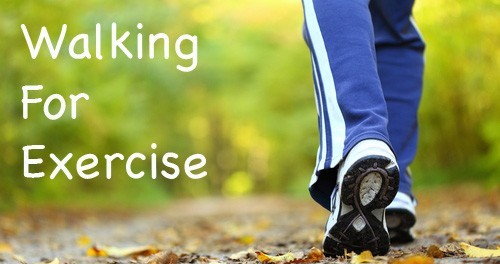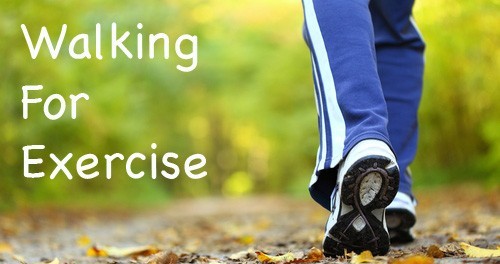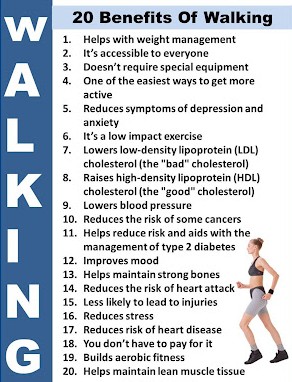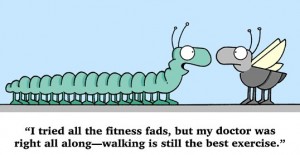Walk Talk Series
Introduction
Walking For Fitness and Weight Loss
If you have decided to start an exercise program, walking is a great and natural way to achieve daily physical activity. Walking can help to improve your health, fitness and can speed your weight loss efforts. We will lead you through a program for absolute beginners, with the goal to have you walking comfortably for 30 minutes to an hour. This is the level that will help prevent Heart Disease, Type Two Diabetes, and Breast and Colon Cancer.
Walking Off Weight
Weight is determined mostly by the balance of calories – how many you burn vs. how many you eat each day. To lose weight, you need to increase your activity to burn more and or eat fewer calories or both each day.
How It Works
Walking at a moderate pace for 30-60 minutes burns stored fat and can build muscle to speed your metabolism. A pound of fat equals 3,500 calories. To lose a pound a week you need to expend 3,500 more calories than you eat that week, either through increased activity or decreased eating or both. Losing 1-2 pounds of fat a week is a sensible and healthy goal. By reducing your calorie intake by 500 calories a day and adding a 500 daily calorie burn from exercise (1000 calories a day) you will lose 2 pounds a week. This is a much more sensible approach then reducing calories by the reduction of food intake alone, due to your body’s nutritional needs.
Health Goals
Walking 30 minutes a day, either 30 minutes at a time or splitting it into two 15 minutes sessions, up to 3 hours per week is associated with a decreased risk of heart disease. By increasing your time to 7 hours per week is associated with a decreased risk of Breast Cancer and Type 2 Diabetes. For this reason, it is recommended that you build up to walking an hour a day, on most days of the week.
Build a Habit
Walk at least 5 days a week, even if some days you must decrease your time, in order to build your new healthy habit. Increase the time you spend walking each week before working on speed. The health benefits of walking begin at the 20- minute per mile speed and a target heart rate of 50-60% max heart rate. At this pace, you may be breathing noticeably harder than usual but still able to carry on a full conversation while walking and not out of breath. Again if this is difficult at first, go slower and build your time before working on speed.
The Absolute Beginner Schedule
Consult a Health Care Provider
Contact your medical provider for a check-up or consultation before you begin your walking program, especially if any of these apply:
Sedentary for a year or more
You don’t currently exercise and are over age 65
You have been diagnosed with heart trouble
Pregnant
High Blood Pressure
Diabetes
You have chest pain, especially when exerting yourself
You often feel faint or have dizzy spells
Other medical condition
What To Wear
Your clothing should be comfortable and loose-fitting to allow you to move. Depending on your climate, you should consider dressing in layers. This allows you to remove a layer as you warm up while walking and put it back if you feel cool. In cooler climates you may want an insulating layer of polar fleece or wool. You may want to invest in garments made of CoolMax or polypropylene if you sweat when walking to wick away moisture. Socks made of CoolMax or other high-tech fibers like in running socks are preferable to cotton, as they prevent blisters by keeping feet drier. A hat and sun glasses is recommended for outdoor walking to prevent UV exposure. Carry water if you plan to be walking for a half hour or more. A hip pack with a built-in water bottle holder is convenient, and can hold other essentials like keys, and cell phone.
Warm-Up
First you want to wake up your muscles and let them know you plan to be active for awhile. Walking at an easy warm-up pace for 5-10 minutes tells your muscles they can’t just sit back and burn up the available sugar; they need to call on the fat reserves. This is why you should not start off at a high speed. When you do that your cells don’t get the signal that this is a long duration activity, so instead they burn sugars only.
Week One
Start with a daily 15 minute walk at an easy pace. Walk five days the first week. We want to build a habit so consistency is important. Spread out your rest days, such as making day 3 and 6 a rest day. Weekly goal: 60-75 minutes.
Week Two
Add five minutes a day so you are walking 20 minutes, 5 days a week. Or you may want to extend yourself more on some days, followed by a rest day. Weekly goal: 75-100 minutes.
Week Three
Add 5 minutes a day so you are walking 25 minutes, 5 days a week. Weekly goal: 100-125 minutes.
Week Four
Add 5 minutes a day to walk 30 minutes, 5 days a week. Weekly goal: 125-150 minutes.
Slower Progress
If you find any week to be difficult, repeat that week rather than adding more time, until you are able to progress more comfortably.
Graduate
Once you are able to walk 30 minutes at a time comfortably, use the same process to build up to 60 minutes a day. Concentrate your training on building distance before you build speed. The calories burned by the extra few minutes of walking far outweigh any other changes you can make.
Feeling Worn
Out If you’re walking workout leaves you feeling sore or worn out the next day, take a day off. If this happens each day that you walk, check your heart rate to be sure you are not overdoing. If so drop down to 50% of your maximum heart rate, and cut back on your duration spent walking.
Seasoned Walkers
For those who have been walking for months or years, you will need to alter your walking style to build more muscles just from walking. Learning to race-walk, you use the increased speed and arm movement to build new muscle and burn more calories per mile. Walking race-walk style at paces under 13-minute miles will burn more calories per mile. If you are already walking 20 miles a week, to achieve more results purely from walking you may want to build speed as well as duration.
Burn More Calories While You Sleep
You can burn more calories, around the clock, even while sleeping by building up your muscle and thus increasing your basal metabolic rate – the number of calories you burn each day at rest. We aren’t talking about Schwarzenegger-like muscles, just toning your legs, arms, stomach and shoulders.
Normal Signs Of Exertion
Increased heart rate, you may feel or hear your heart beat Increased breathing rate, but should be able to carry on a conversation Mild to moderate sweating Muscle aches and tenderness that might last a day or two as you get started
Warning Signs
Please seek immediate attention if you have any of these:
Tightness in your chest and possibly extending into your left arm or neck
Chest pain or pain in your arms or jaw, often on the left side
Wheezing, coughing, or other difficulty in breathing
Severe shortness of breath
Dizziness, fainting or feeling sick to your stomach
Excessive perspiration
Cramps, severe pain or muscle aches
Severe, prolonged fatigue or exhaustion after exercise





